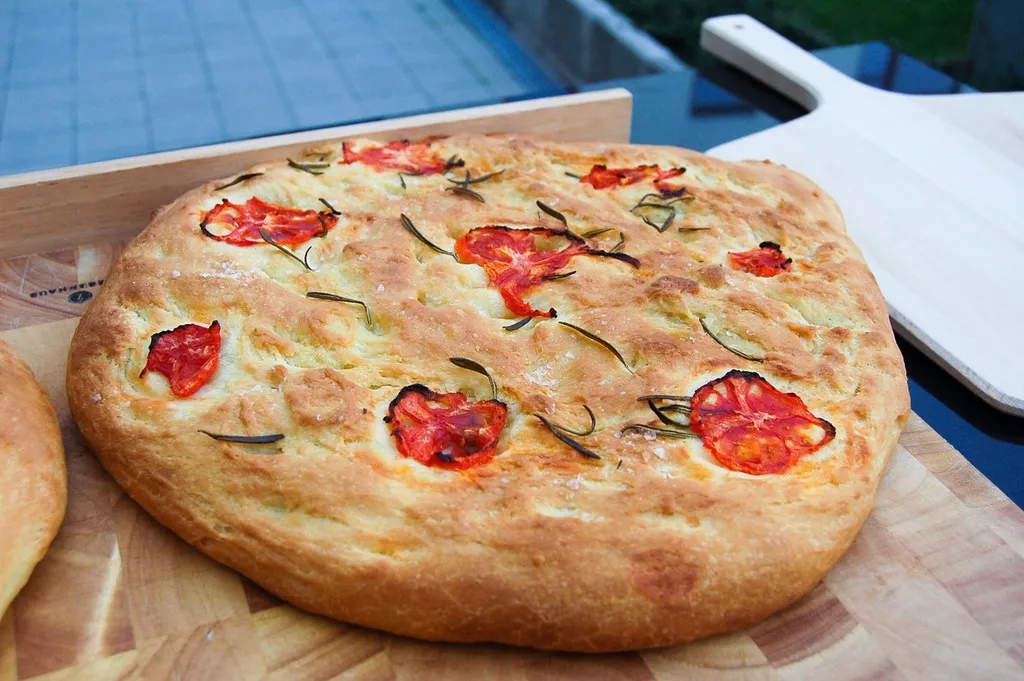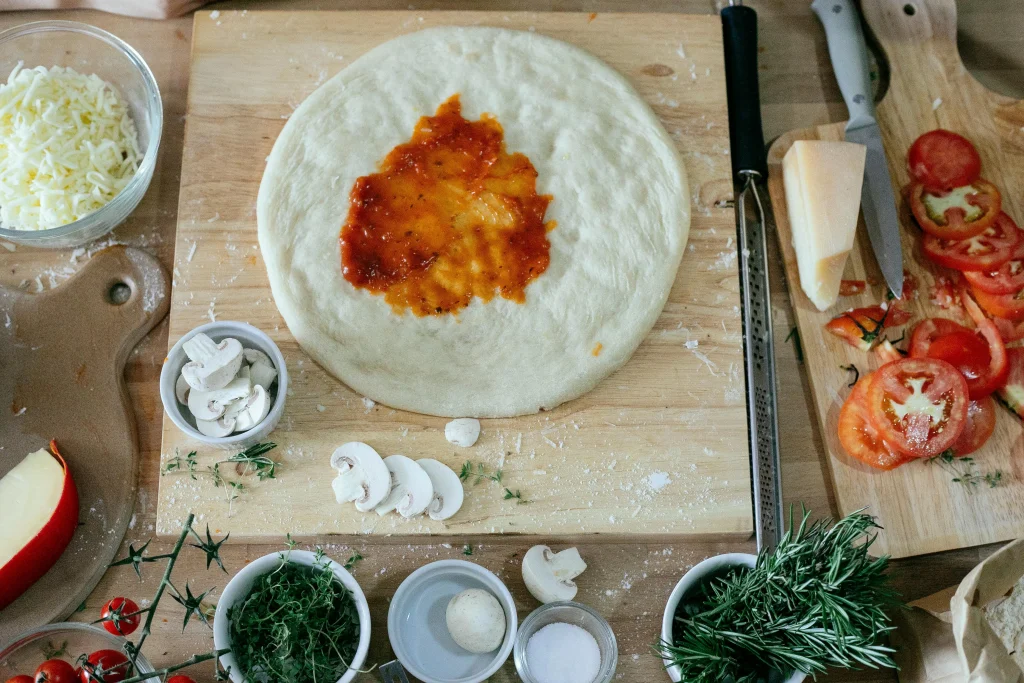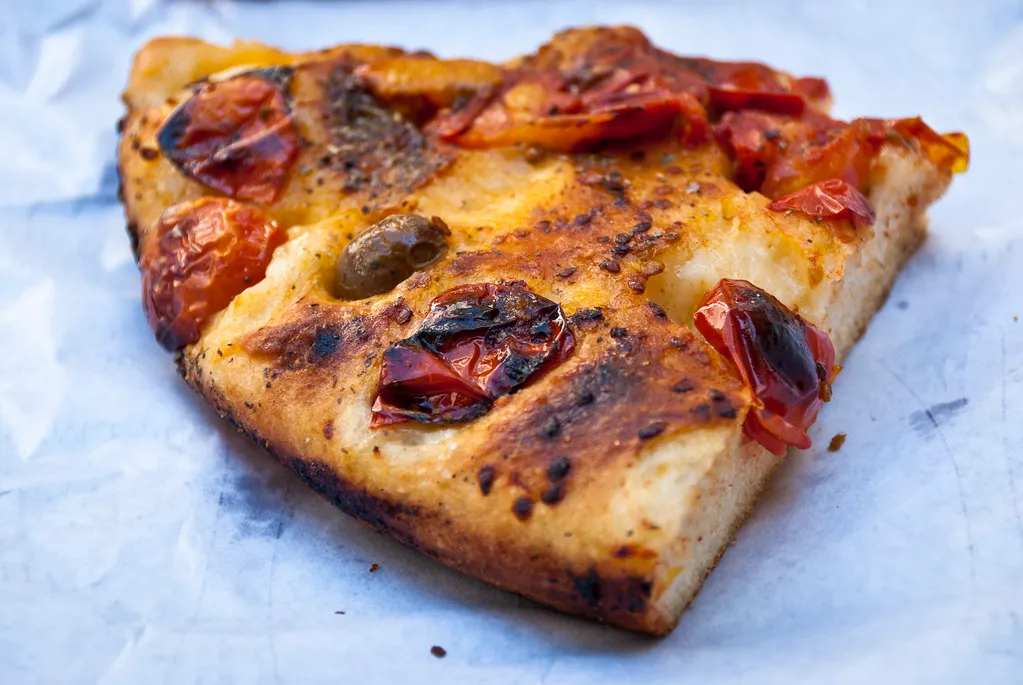The Best Fluffy Pancakes recipe you will fall in love with. Full of tips and tricks to help you make the best pancakes.
If you love homemade pizza but want to try something new, focaccia pizza is the perfect twist on a classic favorite. With its light, airy texture and crispy, olive oil-infused crust, focaccia makes an irresistible base for a flavorful pizza. Whether you prefer a simple Margherita, a Mediterranean-inspired creation, or a bold meat lover’s topping, this guide will show you how to transform focaccia into a delicious pizza masterpiece.
In this post, we’ll cover everything you need to know—from choosing the right ingredients to baking tips that ensure the perfect balance of crunch and chew. Get ready to elevate your homemade pizza game with this easy and delicious focaccia pizza recipe!
Why Focaccia is the Perfect Pizza Base
When it comes to creating the ultimate pizza, the crust is everything. And while traditional pizza dough is delicious, focaccia brings something extra special to the table. Here’s why focaccia is an excellent base for pizza:

The Difference Between Focaccia and Traditional Pizza Dough
Focaccia is an Italian flatbread that’s thicker and fluffier than your standard pizza dough. It’s made with simple ingredients like flour, yeast, olive oil, and salt, but the key difference lies in its preparation. Focaccia dough is often left to rise for a longer period, creating a soft, airy texture that makes every bite feel light yet substantial. Unlike pizza dough, which is typically more elastic, focaccia has a tender crumb with a slightly chewy center. This texture makes it the perfect base for holding toppings without becoming too heavy or soggy.
Olive Oil’s Role in Enhancing Texture and Flavor
One of the standout features of focaccia is its generous use of olive oil. The oil not only helps to create a golden, crisp crust, but it also infuses the dough with a rich, savory flavor that’s hard to match. As the focaccia bakes, the olive oil seeps into the dough, creating a luxurious mouthfeel while maintaining the crispiness on the outside. When used as a pizza base, this olive oil-rich crust provides a beautiful contrast to the juicy toppings, ensuring the pizza is both satisfying and full of flavor.
Crispy Edges with a Soft, Chewy Center
Focaccia offers the best of both worlds when it comes to texture. The edges of the focaccia bake up crispy, while the interior remains soft and chewy. This is ideal for pizza because you get that satisfying crunch with each bite, especially around the outer crust, while the middle section provides a fluffy base that complements your choice of toppings. The airy texture also means the pizza is less likely to feel too heavy or dense, leaving room for a more enjoyable and balanced meal.
Customizable Thickness for Your Perfect Pizza
Another advantage of using focaccia as a pizza base is its customizable thickness. Focaccia can be made thick or thin depending on your preference. A thicker focaccia pizza will have a heartier base, which is great for holding a lot of toppings, while a thinner version can still deliver a crisp and light texture. Either way, the dough’s rich flavor and delightful texture serve as the ideal foundation for all your favorite toppings.
A Perfect Base for Any Topping Combination
The versatility of focaccia as a pizza base cannot be overstated. Whether you’re topping your pizza with fresh mozzarella, tomatoes, or savory meats, focaccia’s mild flavor won’t overpower the ingredients. Its slightly salty and herby taste, especially if you choose to sprinkle rosemary or garlic on top, complements a wide range of pizza toppings. From the simplest margherita pizza to more adventurous Mediterranean or BBQ versions, focaccia serves as a dependable and tasty base that enhances every bite.
Essential Ingredients for a Flavorful Focaccia Pizza
Creating a delicious focaccia pizza starts with the right ingredients. The foundation of a great focaccia pizza lies not only in the dough but also in the toppings, which should complement the rich, olive oil-infused crust. Here’s a breakdown of the essential ingredients that will help you create a flavorful and mouthwatering focaccia pizza.
Flour and Yeast: The Secret to a Light and Airy Crust
The key to a great focaccia base begins with choosing the right flour. High-quality bread flour is ideal because it has a higher protein content, which helps the dough rise and develop a chewy texture. For a slightly softer crumb, you can mix bread flour with a little all-purpose flour, which gives the focaccia a balanced texture.
Yeast is another crucial ingredient. Active dry yeast is commonly used in focaccia dough recipes, as it helps the dough rise and become airy. It’s important to allow the dough to rise for a long time (usually about 1-2 hours), which gives the dough its signature soft and airy texture. The yeast also adds a slight depth of flavor, allowing the focaccia to develop a subtle, tangy taste as it ferments.
Olive Oil and Sea Salt: Creating the Perfect Golden Crust
Olive oil is one of the defining ingredients of focaccia, contributing to both its texture and flavor. Not only does it create a crisp and golden crust, but it also infuses the dough with a rich, savory taste that complements the toppings. For the best results, use extra virgin olive oil for a more robust flavor, which will enhance the overall taste of your focaccia pizza. You can also brush a bit of olive oil on top before baking for a beautiful, glossy finish.
In addition to olive oil, sea salt is another essential ingredient that gives focaccia pizza its characteristic savory taste. The salt highlights the flavor of the olive oil and balances the other ingredients. It’s a simple addition but a powerful one. For an extra touch, consider sprinkling some flaky sea salt on top of the focaccia dough before baking, which will add texture and a delightful burst of saltiness.
Herbs and Seasonings: Elevating the Flavor Profile
Focaccia pizza’s flavor profile is greatly enhanced by herbs and seasonings. The most common herb used in focaccia is rosemary, which pairs beautifully with the olive oil and adds a fragrant, earthy note. Fresh or dried rosemary can be sprinkled on top of the dough, giving it a lovely aromatic quality as it bakes.
Other herbs, such as garlic, thyme, or oregano, can also be used to enhance the flavor of your focaccia base. A hint of garlic can make the crust extra flavorful, while thyme and oregano can bring out Mediterranean flavors. If you want to experiment with more complex flavors, try adding a touch of basil or sage. The key is to keep the seasonings balanced so they complement the toppings, rather than overpower them.
Cheese and Toppings: The Finishing Touches for Your Pizza
The right combination of cheese and toppings is essential for transforming your focaccia into a satisfying pizza. For the cheese, mozzarella is the most popular choice because of its melty, gooey texture and mild flavor. Fresh mozzarella adds a creamier, slightly tangy taste, while low-moisture mozzarella gives a more substantial melt. You can also mix mozzarella with other cheeses like Parmesan for a sharper, more savory flavor.
For a classic pizza, you can use tomato sauce as a base, or if you prefer something lighter, try an olive oil base. The toppings are where you can get creative! Fresh vegetables like tomatoes, bell peppers, onions, or mushrooms are excellent choices. For meat lovers, pepperoni, sausage, or prosciutto add richness to the pizza. Don’t forget about fresh greens like basil, arugula, or spinach, which can be added after baking for a burst of freshness and color.
For extra flavor, consider adding a drizzle of balsamic glaze or a sprinkle of crushed red pepper flakes to finish off your pizza. These little touches can elevate the taste and add an extra dimension to your focaccia pizza.
How to Make Focaccia Pizza Step by Step
Making focaccia pizza is a fun and rewarding process, with just a few simple steps to follow. This section will guide you through each part of the process—from preparing the dough to adding your favorite toppings, and finally baking your pizza to perfection. Follow these steps for a delicious, crispy, and airy focaccia pizza every time!

Step 1: Prepare the Focaccia Dough
In a large bowl, combine:
- 2 ½ cups all-purpose flour
- 1 teaspoon salt
- 1 tablespoon sugar
- 1 packet (2 ¼ teaspoons) active dry yeast
- 1 cup warm water (about 110°F or 45°C)
- 2 tablespoons olive oil
Dissolve the yeast in the warm water to activate it.
Once dissolved, mix in the flour and salt, then pour in the olive oil. The olive oil is essential for creating a rich, golden crust and adding flavor.
Knead the dough for about 5-10 minutes, or until it becomes smooth and elastic. If the dough feels too sticky, add a little more flour, but avoid making it too dry. The dough should be soft and slightly tacky.
Cover the dough with a clean cloth and let it rise in a warm place for about 1 to 1.5 hours, or until it has doubled in size. This step helps the dough develop the soft, airy texture characteristic of focaccia.
Step 2: Shape and Rise the Dough
Once the dough has risen, it’s time to shape it. Lightly oil your baking sheet or pizza stone to prevent sticking. Gently press the dough down with your hands to deflate it slightly, then transfer it to the prepared pan. Using your fingers, press the dough out to fit the shape of the pan, making it about 1/2 to 1 inch thick, depending on how thick you want your focaccia crust.
After shaping the dough, let it rise for another 30 minutes to an hour. This second rise helps the dough become even lighter and fluffier, which will give your focaccia pizza a perfect airy texture. During this time, you can preheat your oven to 400°F (200°C) to ensure it’s hot and ready for baking.
Step 3: Add Flavorful Toppings to the Dough
- Before adding toppings, brush the surface of the dough with a generous amount of olive oil. This not only enhances the flavor but also helps the dough bake to a golden brown.
- Use your fingers to create small indentations all over the surface of the dough. This is a signature feature of focaccia and will help the toppings and oil sink in as it bakes.
- Now, it’s time to add your toppings:
- For a traditional pizza, start by spreading a thin layer of tomato sauce.
- For a lighter, oil-based pizza, simply brush the dough with more olive oil and skip the sauce.
- Add your cheese: mozzarella is the most common choice, but you can mix in other varieties like Parmesan or cheddar for extra flavor.
- Arrange your toppings evenly over the surface. Popular ingredients include fresh basil, mushrooms, onions, peppers, and olives, but feel free to get creative with your favorites!
Step 4: Bake the Focaccia Pizza
Once your pizza is fully topped, it’s time to bake! Place the pizza in your preheated oven (400°F or 200°C) and bake for about 15-20 minutes, or until the crust is golden brown and the cheese is melted and bubbly. The exact baking time will vary depending on your oven and the thickness of the dough, so it’s important to keep an eye on it as it bakes. If you like a slightly crispier crust, you can bake it for an additional 5 minutes.
If you’re adding any delicate greens like arugula or spinach, it’s best to add them after the pizza has finished baking. This will keep them fresh and vibrant, rather than wilting in the oven.
To take your focaccia pizza-making to the next level, consider using the Ninja Foodi Digital Fry, Bake, Broil, and Dehydrate Oven. This versatile kitchen appliance offers multiple cooking functions, including air frying, baking, broiling, and even dehydrating. With its intuitive digital controls and large capacity, it ensures even cooking, making it perfect for reheating your focaccia pizza to crispy perfection. Whether you’re baking your pizza dough or reheating leftovers, the Ninja Foodi helps save time while maintaining the pizza’s quality and flavor.
Step 5: Add Final Touches and Serve
Once your focaccia pizza is out of the oven, let it cool for a few minutes before slicing. This helps the crust set and makes for cleaner cuts. For an extra burst of flavor, consider drizzling a bit of balsamic glaze over the top or adding a sprinkle of crushed red pepper flakes for some heat. You can also add fresh herbs like basil or oregano to bring even more flavor.
Slice your focaccia pizza into squares or traditional wedges and serve hot. This pizza is perfect as an appetizer, snack, or main dish, and pairs beautifully with a side salad or a glass of wine.
Tips for Perfect Focaccia Pizza
- Use room temperature ingredients: Bringing ingredients like water and oil to room temperature helps the dough rise more evenly.
- Don’t rush the rising time: The longer the dough rises, the fluffier and more flavorful your focaccia will be. Be patient during both rises to ensure a perfect texture.
- Experiment with toppings: Don’t be afraid to get creative! Focaccia pizza is extremely versatile, so you can customize it to your taste. Try caramelized onions, roasted garlic, sun-dried tomatoes, or even figs for a unique twist.
- Check the dough before baking: If the dough looks too thick, gently press it down with your fingers to stretch it out a little more. The dough should be thin enough to crisp up but still have some thickness for the perfect bite.
Topping Ideas to Elevate Your Focaccia Pizza
The beauty of focaccia pizza lies in its versatility—its rich, olive oil-infused crust acts as the perfect base for a wide variety of toppings. Whether you’re in the mood for something classic, creative, or completely adventurous, the right combination of ingredients can take your focaccia pizza to the next level. Here are some topping ideas to help you elevate your focaccia pizza into a gourmet masterpiece.

1. Classic Margherita: Simple Yet Flavorful
A Margherita pizza is a timeless favorite that’s always a crowd-pleaser. For a classic Margherita focaccia pizza, all you need are a few simple ingredients that come together to create a deliciously satisfying pizza. Start with a thin layer of tomato sauce (or skip the sauce for a more rustic feel), and top with fresh mozzarella cheese. For extra flavor, sprinkle on some fresh basil leaves and finish with a light drizzle of extra virgin olive oil. Bake until the cheese is melted and bubbly, and the edges of the focaccia are golden and crispy. This combination highlights the fresh, vibrant flavors of the ingredients and allows the focaccia dough to shine through.
2. Mediterranean-Inspired Toppings
If you love Mediterranean flavors, focaccia pizza is a perfect base to explore a range of savory and fresh toppings. Consider making a Mediterranean focaccia pizza with ingredients like black olives, feta cheese, cherry tomatoes, red onions, and artichoke hearts. You can also add a sprinkle of oregano or thyme for an aromatic touch. For a fresh, herbaceous finish, top with a handful of arugula or baby spinach after the pizza comes out of the oven. A drizzle of balsamic glaze can add a touch of sweetness and acidity that complements the salty olives and feta perfectly.
3. Roasted Vegetable Delight
For a hearty, wholesome focaccia pizza, roast a variety of vegetables to bring out their natural sweetness and add depth to your pizza. Zucchini, bell peppers, eggplant, onions, and mushrooms all make fantastic toppings when roasted. To prepare, toss the vegetables in olive oil, salt, and pepper, and roast them in the oven until tender and slightly caramelized. Spread a thin layer of garlic-infused olive oil over the dough, then layer on your roasted vegetables. Add a sprinkle of Parmesan cheese for a savory finish. This combination works especially well if you prefer a pizza without traditional tomato sauce, allowing the flavors of the roasted veggies to take center stage.
4. Meat Lovers’ Paradise
If you’re craving a meaty pizza, focaccia dough is sturdy enough to support a variety of rich and savory meats. Start with a base of tomato sauce and layer on your favorite meats such as pepperoni, sausage, bacon, or prosciutto. You can also mix in some salami or ground beef for extra texture. To balance out the richness of the meat, consider adding some red onions or a sprinkle of chili flakes for a bit of heat. Top with plenty of mozzarella cheese and bake until everything is perfectly melted and golden. For a final touch, add a handful of fresh basil after baking to add a pop of color and freshness.
5. Sweet and Savory Combinations
Sweet and savory combinations are a great way to create a more adventurous focaccia pizza. A prosciutto and fig pizza is a delightful pairing of salty and sweet flavors. Spread a thin layer of fig jam on the dough, then layer on slices of prosciutto and fresh mozzarella. After baking, drizzle a bit of balsamic reduction over the top to enhance the sweet and savory contrast. You can also try adding some arugula for a fresh, peppery bite that balances out the richness of the prosciutto.
Another great sweet-savory option is a pear and blue cheese focaccia pizza. Spread a bit of olive oil on the dough and top with thin slices of pear, crumbled blue cheese, and a drizzle of honey. This combination offers a sophisticated and flavorful twist on a classic pizza.
6. Barbecue-Inspired Focaccia Pizza
For something a little different, try a barbecue-inspired focaccia pizza. Use barbecue sauce instead of tomato sauce for the base, and top with shredded chicken, red onions, and cilantro. You can also add some corn kernels or jalapeños for extra texture and heat. To make it even more indulgent, add a generous layer of cheddar cheese or mozzarella. The smoky, tangy barbecue sauce pairs perfectly with the sweet onions and spicy toppings, creating a unique and flavorful pizza.
7. Breakfast-Inspired Focaccia Pizza
Who says pizza is just for dinner? For a fun breakfast twist, you can turn your focaccia pizza into a morning meal. Top it with scrambled eggs, cheddar cheese, and crispy bacon for a breakfast pizza that’s sure to satisfy. You can also add avocado slices, sautéed spinach, or a handful of cherry tomatoes for extra freshness. For a little spice, consider adding a sprinkle of chili flakes or a drizzle of sriracha for some heat. This breakfast pizza is a great way to enjoy your favorite morning flavors in a new and exciting form.
8. Unique Global Flavors
For a truly unique take on focaccia pizza, explore flavors from around the world. Consider a Thai-inspired pizza with a base of peanut sauce, topped with grilled chicken, carrots, cabbage, and cilantro. After baking, garnish with chopped peanuts and a squeeze of lime juice for an extra burst of flavor.
Another option is a Indian-inspired pizza with a butter chicken base. Spread a layer of butter chicken sauce on the focaccia dough and top with grilled chicken pieces, cilantro, and a sprinkle of garam masala. The aromatic spices of the garam masala will infuse the crust, creating a flavorful and exotic twist on traditional pizza.
Serving, Storing, and Reheating Tips
Making focaccia pizza is a treat, but knowing how to properly serve, store, and reheat it will ensure that your delicious creation stays fresh, tasty, and enjoyable even after the initial serving. Whether you’re planning for leftovers or want to impress guests with your presentation, these tips will help you get the most out of your focaccia pizza.
Serving Your Focaccia Pizza
Serve Immediately for Best Texture
Focaccia pizza tastes best when served hot and fresh out of the oven. The crispy edges and soft, fluffy center provide the perfect contrast in texture, which can be lost if left to cool too long. If you’re serving a large group, consider cutting and serving the pizza in batches to ensure everyone enjoys it at its peak texture.
Slice with Precision
After baking your focaccia pizza to perfection, it’s time to slice it. Because focaccia is typically thicker than traditional pizza, use a serrated knife or a pizza cutter for cleaner cuts. You can choose to slice it into squares, which gives it a rustic, casual feel, or go for traditional wedges, depending on your preference. If you’re serving it as an appetizer, smaller squares work well; if it’s the main dish, larger slices are more filling.
Garnish for Visual Appeal
While focaccia pizza is delicious on its own, a garnish can elevate the visual appeal. Adding fresh herbs like basil, oregano, or rosemary after baking not only enhances the look but also brings out the flavors. A drizzle of balsamic glaze, olive oil, or a sprinkle of Parmesan cheese can also be added to give it an extra touch of elegance. For a more sophisticated look, add a few arugula leaves or thin slices of prosciutto just before serving for a burst of freshness and a flavor contrast.
Pair with a Beverage
Focaccia pizza is incredibly versatile when it comes to pairing with
- Red Wine: Serve with a glass of red wine, such as Chianti or Merlot, to complement the richness of the olive oil and cheese.
- White Wine: If you prefer white wine, a crisp Sauvignon Blanc or a refreshing Pinot Grigio works wonderfully with the pizza’s flavors.
- Non-Alcoholic Options: Pair your focaccia pizza with sparkling water or a cold iced tea for a refreshing alternative.
- Side Salad: A side of Mediterranean salad or a light arugula salad is a perfect complement to balance the richness of the pizza.
Storing Your Focaccia Pizza
Cool Before Storing
After you’ve enjoyed your focaccia pizza, allow any leftovers to cool to room temperature before storing them. This prevents condensation from forming inside the storage container, which could make the crust soggy. Avoid leaving pizza out for more than two hours to ensure food safety.
- Wrap and Store:
To keep your focaccia pizza fresh, wrap it tightly in plastic wrap or store it in an airtight container. If you have multiple slices, you can separate them with wax paper to prevent them from sticking to each other. It’s best to store the pizza in the fridge if you plan to eat it within the next few days. - Storing for Longer:
If you don’t plan on eating the leftover pizza within a couple of days, you can freeze it. Wrap each slice individually in plastic wrap or foil, and then place them in a freezer-safe bag or airtight container. This will help preserve the pizza’s flavor and texture for up to 2-3 months. When you’re ready to eat it, simply thaw it in the fridge overnight or reheat it directly from the freezer.
Reheating Your Focaccia Pizza
Reheat in the Oven for the Best Results
To keep the crust crispy, the oven is the best method for reheating focaccia pizza. Preheat your oven to 375°F (190°C) and place the pizza on a baking sheet. Loosely cover the pizza with aluminum foil to prevent the toppings from burning while retaining moisture. Reheat for 10-12 minutes, or until hot and crispy. For a bubbly, golden top, remove the foil during the last 2-3 minutes.
Reheat Using a Skillet for a Crispier Crust
For a quick and crisp reheating method, use a skillet. Heat a non-stick skillet over medium heat and place a slice of pizza in the pan. Cover with a lid to trap the heat and warm through for 3-5 minutes. If you prefer a slightly softer crust, add a splash of water to the skillet and cover it to create steam.
Microwave with Caution
Microwaving is the fastest method but can lead to a soggy crust. To minimize this, place a damp paper towel over the pizza to preserve moisture. Heat in 30-second intervals, but keep in mind the crust won’t be as crispy as when reheated in the oven or skillet.
Reheat From Frozen
If you froze your focaccia pizza, you can reheat it directly from the freezer. Preheat your oven to 375°F (190°C) and bake for 15-20 minutes. For a single slice, you can also use the skillet method to reheat, as mentioned above.
Additional Tips for Optimal Storage and Reheating
- Keep toppings in mind: Some toppings, like fresh greens, arugula, or soft cheeses, are best added after reheating to avoid wilting or losing their flavor.
- Avoid overcrowding: If storing multiple slices, give each slice enough space in the container or wrap them separately to avoid sogginess.
- Avoid multiple reheats: While you can reheat pizza, it’s best not to reheat it more than once, as this can lead to a loss of flavor and texture.





